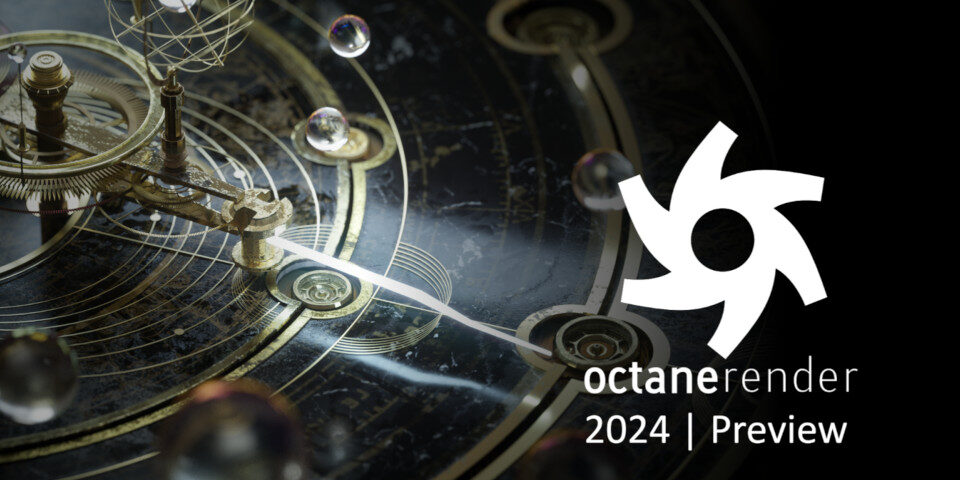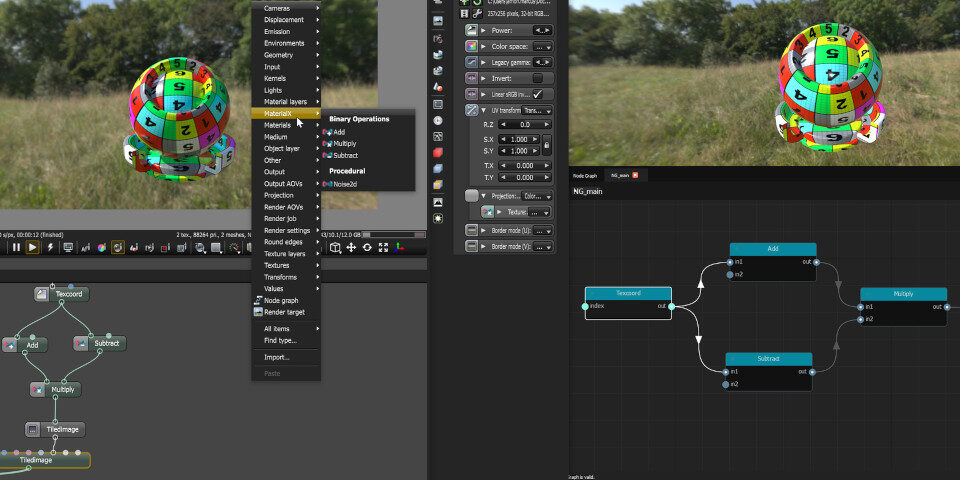Otoy unveils the Octane 2024 product roadmap

Otoy has released details of its Octane 2024 roadmap, previewing new features due in 2024 in OctaneRender, its GPU production renderer, and Octane X, its macOS and iOS edition.
Support for multi-platform network rendering is already available in public preview, in the initial alpha build of OctaneRender 2024.1.
Features due to be added in later builds of OctaneRender 2024.1 include MaterialX support, new AI assistant OctaneGPT, light field baking, and the Brigade temporal denoiser.
Features now due to be added later in the 2024.x release cycle include neural rendering, multi-rendering, and a new volumetric live compositor.
Now available in OctaneRender 2024.1: mixed-platform network rendering
Major changes already available in preview in the initial alpha of OctaneRender 2024.1 include the software’s new geometry pipeline.
It unifies the memory layouts used for geometry between CUDA and Metal, making it possible to mix Macs with Windows and Linux machines in render networks.
The new pipeline also extends OctaneRender’s use of the RT cores in NVIDIA GPUs to all mesh primitives, including hair, spheres and displacement triangles, improving render performance.
Other changes include a new denoising system based on the Open Image Denoise (OIDN) framework, and new options for post-processing render passes in the AOV Compositor.
You can read about these features in more detail in our story on OctaneRender 2024.1.

Future builds of OctaneRender 2024.1 will introduce native support for MaterialX, the VFX industry standard for look dev and rich material data, including via OSL nodes, as shown here.
Due in future builds of OctaneRender 2024.1: MaterialX, OpenPBR and OctaneGPT
New versions of OctaneRender go through multiple builds before the feature set is locked, so more new features are scheduled for OctaneRender 2024.1 before the stable release.
They include native support for open look dev and material standard MaterialX, including its OpenPBR subproject.
OctaneRender 2024.1 will also feature OctaneGPT, a ChatGPT-style Large Language Model service that will provide in-application help, and that will be able to generate new nodes, shaders, scripts – and even complete scenes – interactively from users’ text or voice prompts.
Due in future builds of OctaneRender 2024.1: light field baking
Other features scheduled for future builds of OctaneRender 2024.1 include light field baking.
Otoy describes it as “high-performance reflectance field caching for rendering Octane scenes at 120fps with final-frame quality”, but doesn’t go into any more detail in its forum post.
You can see brief demos above and in this video of Otoy CEO Jules Urbach at the Blender Conference, where he discusses support for Apple’s upcoming Vision Pro mixed reality headset.
Due in future builds of OctaneRender 2024.1: Brigade denoising and meshlet streaming
The other features described as being in “active development” for OctaneRender 2024.1 will be more familiar to regular readers, since Otoy has announced them before for previous releases.
They include real-time temporal denoising via the Brigade spectral rendering kernel, previously scheduled to become available in OctaneRender 2022.1.
According to Otoy, “real time filtering for path traced rays [is already in the] 2023 core”, and will now be exposed in the integration plugins, starting with Unreal Engine, Blender and Cinema 4D.
Meshlet streaming, a scene streaming system that Otoy compares to Nanite, the virtualised geometry system introduced in Unreal Engine 5.0, is a bit further off.
Meshlet texture streaming is due in OctaneRender 2024.1, but geometry streaming is now scheduled for later in the 2024.x release cycle.
Due later in the 2024.x cycle: neural rendering, multi-render and volumetric compositing
Neural rendering, previously announced as part of the Octane 2023 product roadmap, is also now due later in the 2024.x release cycle.
According to Otoy’s latest blog post, it will support a range of AI-based techniques, including “NeRF, splats [presumably 3D Gaussian Splatting] and generative AI scene nodes”.
The multi-render system, previously scheduled for OctaneRender 2021, is also now due in 2024.x, in the shape of “headless rendering with multi-render and multi-engine live linking”.
Other features scheduled for the 2024.x release cycle include a “volumetric live compositor for virtual production and mixed reality and light field displays”, and a new network render manager.
How likely is it that all of these features will actually ship in 2024?
Otoy tends to be very optimistic in its public roadmaps, as you can judge by comparing what it announced in its Octane 2023 roadmap and what actually shipped in OctaneRender 2023.1.
When considering features scheduled for 2024.x, it’s also worth noting that so far this decade, Otoy has rarely put out two stable releases of OctaneRender in a calendar year.
Price and system requirements
OctaneRender 2024.1 is currently in alpha. Otoy hasn’t announced a final release date yet, but other recent updates have taken 6-12 months to get from the initial preview to a stable release.
You can find details of current pricing and system requirements in this story.
Read Otoy’s announcement of the Octane 2024 roadmap on its blog
Read a longer discussion of the new features on Otoy’s forum
Have your say on this story by following CG Channel on Facebook, Instagram and X (formerly Twitter). As well as being able to comment on stories, followers of our social media accounts can see videos we don’t post on the site itself, including making-ofs for the latest VFX movies, animations, games cinematics and motion graphics projects.
